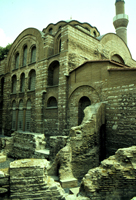The Kalenderhane mosque in Istanbul is located in the center of the old city at the eastern end of the Valens Aqueduct, and was excavated and restored by Prof. Cecil L. Striker (Penn, History of Art) and Prof. Dogan Kuban (Istanbul Technical University), in collaboration with the Dumbarton Oaks Center for Byzantine Studies between 1966 and 1978.

The Kalenderhane mosque in Istanbul is located in the center of the old city at the eastern end of the Valens Aqueduct, and was excavated and restored by Prof. Cecil L. Striker (Penn, History of Art) and Prof. Dogan Kuban (Istanbul Technical University), in collaboration with the Dumbarton Oaks Center for Byzantine Studies between 1966 and 1978.
Their study revealed that the existing building was originally the church of the Kyriotissa Monastery and was built in the years 1197-1204, replacing and incorporating the remains of seventh and sixth century churches and a small Roman bath built around 400 A.D. A wall mosaic found in the sixth century church depicts the Presentation of the Christ Child in the Temple, and is the only wall mosaic to have survived from the pre-Iconoclast era in Constantinople.
Fragmentary frescos depicting the life of St. Francis of Assisi, found in a side chapel and painted around 1250 during the occupation of Constantinople by the Fourth Crusade, are the earliest surviving mural paintings of the life of the saint. The mosaic and frescos are on display in the Istanbul Archaeological Museum, and the building was restored for use again as a mosque.
